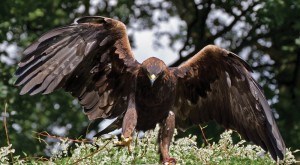
The east part of Jasper National Park is a gusty place. Winds scour the valley bottom, accelerating as they push up steep limestone mountain sides. Warm air rises, twisting into circular columns known as thermals, and on warm days in March and April, these are often the lift beneath the two-metre wingspan of migrating golden eagles.
Right now, the golden eagle superhighway is in full swing, with raptor traffic running up the front ranges of the Canadian Rockies. Eagles soar from one pillar of air to the next with barely a beat of their wings, covering vast distances with little energetic expense.
In some parts of the province—for example, a prominent viewing location at Mount Lorette in Kananaskis—hundreds of eagles can be seen making their way north to the Yukon and Alaska in the span of a day, depending on the weather.
Thousands of eagles will take part in the migration.
Here in Jasper, the eagle flyway is observable between Roche Miette and Roche Ronde, and more commonly Roche Perdrix and Benson Ridge. “Most of the ones I see are hugging the ridge, and often they’ll fly over the marsh,” says Elaine Slatter, a long-time Pocohontas resident. “The first time it happens each spring, it’s pretty exciting.”
On March 9, Slatter saw 25 pass over within half an hour.
Viewing is “hit and miss,” she says. Slatter looks for them in the warm part of the day, after 2 p.m., when strong west winds create an updraft in the afternoon. While there is no formal count in Jasper, as of March 20, 1,345 golden eagles had been observed passing over the Mount Lorette area in Kananaskis, pushing north.
To say golden eagles are brown doesn’t quite describe them. Feathers on the back of the head and neck do in fact appear golden, and younger birds have white patches near the base of the tail and on their wings. Of course, this can be hard to see when they’re high in the sky, so if you’re interested in viewing them, best to bring binoculars, and get familiar with their silhouette.
Their hunting prowess is legendary. According to the Cornell Lab of Ornithology, golden eagles can kill large prey such as cranes, deer and domestic livestock, although they usually keep to rabbits, hares, ground squirrels and prairie dogs.
They have even been observed killing seals, mountain goats, bighorn sheep, pronghorn, coyotes, badgers and bobcats, and at times hunting in groups.
But, given their ferocious reputation, the golden eagle’s call is a bit, well, lacking. It sounds like someone licked their finger and is using it to rub a balloon.
Still, it would be terrifying to be the focus of their hunt. They dive for kills like small fighter jets—some clock at 322 km/per hour—and their massive talons are equipped with a ratcheting mechanism that allows them to grip with what is imaginably excruciating pressure and consistency.
Once north, golden eagles will build nests you could sleep a child in—roughly one to two meters wide and just over half a meter deep. Their nests are often on cliffs, but also in trees, on telephone poles and anywhere else they can scope out dinner from the comforts of home. You might even see some of them around here.
By the fall, they’ll trickle back south, headed for more seasonable climates, along with freshly-fledged travellers of the golden eagle superhighway.
Niki Wilson
Special to the Fitzhugh
